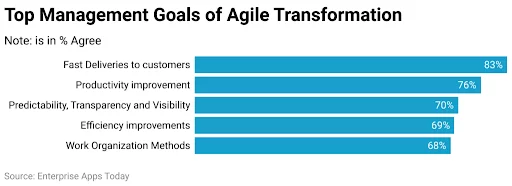AI/ML
Understanding Agile Transformation: Definition, Benefits, and Key Stages
Imagine a world where your organization effortlessly adapts to customer needs, consistently delivers high-quality products on time, and gains a competitive edge in the ever-evolving market. This ideal scenario may seem like a long journey, but it’s entirely attainable for organizations that have successfully embraced Agile transformation.
A PwC study revealed that Agile projects enjoy a 28% higher success rate than traditional projects. As a result, gaining a thorough understanding of Agile transformation is crucial for anyone seeking to steer their organization towards greater success and improved performance.
This comprehensive blog will delve into the definition, benefits, and key stages of agile transformation.
So, let’s get started!
What is Agile Transformation?
Agile transformation is transitioning an organization from its current state to a more agile, flexible, and customer-centric one. It involves a complete shift in mindset, culture, and practices, enabling organizations to adapt quickly to market changes, deliver value faster, and improve collaboration and communication.
At its core, agile transformation is based on key principles. These principles include:
- Prioritizing customer satisfaction through continuous delivery of valuable products or services.
- Even late in a project, embracing change to capitalize on new opportunities.
- Delivering working solutions frequently, with a preference for shorter timescales.
- Collaborating closely between business stakeholders and development teams.
- Building projects around motivated individuals gives them the resources and support they need.
- Emphasizing face-to-face communication for conveying information.
- Measuring progress primarily through the delivery of working solutions.
- Maintaining a sustainable pace of work for the team.
- Striving for technical excellence and good design.
- Keeping things simple and focusing on what’s necessary.
- Allowing self-organizing teams to make decisions.
- Reflecting regularly on performance and adjusting as needed for continuous improvement.
It’s important to distinguish Agile transformation from Agile adoption.
Agile adoption is the process of implementing specific Agile practices, methodologies, or frameworks (such as Scrum or Kanban) within a team or organization.
While Agile adoption is a crucial component of Agile transformation, it doesn’t encompass the full scope of the transformation. Agile transformation goes beyond adopting specific practices and involves a fundamental shift in how an organization operates, thinks, and makes decisions.
But at the same time, it is important to understand that in the agile transformation journey, one can encounter failures. Various factors must be considered, and best practices should be followed to avoid facing agile failures.
6 Benefits of Agile Transformation
As we know, Agile transformation involves implementing an agile mindset and culture within an organization. This involves introducing new frameworks and practices that encourage collaboration, flexibility, and responsiveness. It can disorient individuals and teams, so those introducing the idea of agile working must communicate why the changes are being implemented and how it will benefit the organization.
Agile transformation offers many benefits that can significantly impact an organization’s performance and culture; 71% of US companies have adopted it.
When implemented properly, Agile Transformation can bring a number of benefits to an organization.
The top benefits of using agile transformation include the following:
1. Increased Customer Satisfaction
Agile software development stresses flexibility, cooperation, and quick iteration. Agile methods make it easier for development teams to incorporate client feedback, resulting in a better product.
Agile emphasises continuous software delivery to satisfy customers. This means the development team continuously makes small product modifications and gets user input. By doing so, the team will quickly make modifications and guarantee the product meets client demands.
Agile also emphasises close collaboration between the development team and the customer. This helps the team identify client wants and priorities and create a satisfying solution.
2. Improved Product Quality
Agile methodologies place a strong emphasis on continuous improvement and feedback. Teams can test and improve their products throughout development by using iterative development. This helps them identify and resolve issues before they become more costly and harder to remedy.
In Agile, product quality is not simply the QA team’s duty. Instead, it’s the team’s job, from developers to testers to product owners. Agile approach guarantees quality is incorporated into the product from the start by involving all team members in quality assurance.
Agile practices also prioritize customer feedback, which helps teams understand customers’ needs and expectations. This helps them design products that fulfill client needs and expectations, increasing customer happiness.
Automated testing is another important part of Agile development. These tools can quickly and efficiently test code changes, catching issues before they are integrated into the product. This lowers the chance of product issues and lets teams focus on new features and capabilities.
3. Enhanced Team Collaboration And Communication
Agile transformation can enhance team collaboration and communication in many ways. Cross-functional teams working toward the same objective are one of Agile’s core concepts. This implies that developers, testers, and designers collaborate throughout the development process.
The Agile approach emphasizes face-to-face communication and regular meetings, such as daily stand-ups and sprint retrospectives. These meetings help to keep team members aligned, identify and address issues early, and ensure that everyone is working towards the same goals.
Another important aspect of Agile methodologies is the use of visual management tools such as Kanban and task boards. These tools help team members see the status of tasks and projects at a glance, which promotes transparency and accountability.
4. Faster Time-To-Market
This benefit is one of the primary reasons organizations adopt Agile methodologies.
Agile methodologies emphasize iterative development, where small increments of work are delivered frequently. The team can quickly deliver working software or products in shorter cycles. As a result, organizations can respond more quickly to market changes and customer needs.
In traditional development methodologies, such as Waterfall, development is typically done in large, sequential phases. Each process must be completed before going on to the next, which might take time and delay product delivery. In contrast, Agile methodologies allow for more flexibility and the ability to deliver smaller increments of work more frequently.
In today’s competitive corporate environment, faster time-to-market can be crucial. Organizations that deliver products or services faster can gain a competitive advantage and better meet their customers’ needs.
In addition to a faster time-to-market, Agile methodologies also enable organizations to be more responsive to customer feedback. By delivering working software or products in shorter cycles, organizations can gather customer feedback early in the development process and make necessary adjustments. This leads to a better end product that more closely aligns with customer needs.

5. Greater Adaptability To Change
Greater adaptability to change is one of the most significant benefits of Agile transformation. To be competitive in today’s fast-paced business world, businesses must react instantly to shifting market conditions, consumer requirements, and developing technology. Agile methodologies are designed to help organizations do just that.
Agile approaches, such as Scrum and Kanban, focus on delivering value incrementally, with regular opportunities for feedback and course correction. This iterative strategy lets teams quickly adapt to changing priorities and needs, making it easier for enterprises to make changes.
In contrast to traditional project management methodologies, which rely on detailed upfront planning and strict adherence to a predetermined plan, Agile methodologies embrace change as a natural part of the development process. Agile teams are empowered to react and modify depending on stakeholder feedback and real-world experience rather than trying to forecast and plan for every possibility.
Organizations can gain a competitive edge by adapting quickly to changing conditions. It helps them find new possibilities, meet client requirements faster, and beat the competition. Agile approaches may help firms survive today’s fast-changing business environment by fostering flexibility and adaptation.
6. Higher Employee Morale And Engagement
Agile transformation can create a more collaborative and empowered work culture, leading to higher employee morale and engagement. Agile methods allow cross-functional teams to collaborate by breaking down silos and hierarchies. This encourages responsibility, accountability, creativity, and innovation.
Agile teams have more autonomy and decision-making authority, which may enhance morale and work satisfaction. Organizations may encourage and engage workers by giving them decision-making authority.
10 Key Stages of Agile Transformation
The journey to Agile transformation is not only crucial but can be highly rewarding. Cultivating a robust Agile culture within your organization can lead to a remarkable 237% enhancement in commercial performance.
Agile transformation is a way to transform the way work is done in an organization. The goal of an Agile transformation is to move away from traditional “big-bang” product releases and instead focus on regular, incremental delivery. To achieve this, the transformation should be managed in the same way that regular, incremental delivery is managed: through stages.
To reap the benefits of agile transformation, organizations must follow these 10 key stages:
Stage 1: Organizational Readiness Assessment
Organizational Readiness Assessment is the first stage of Agile transformation, which involves evaluating the organization’s culture, leadership style, and existing processes to determine its readiness to adopt Agile practices. It involves:
- Identifying the organization’s strengths and weaknesses
- Understanding its current processes,
- Assessing the level of support and commitment from senior leadership
This stage also involves identifying potential barriers to Agile adoption, such as resistance to change or a lack of buy-in from key stakeholders.
By conducting an organizational readiness assessment, organizations can better understand the potential challenges they may face in implementing Agile practices and develop strategies to overcome them, ensuring a smoother and more successful transition to Agile methodologies.
Stage 2: Vision and Goal Setting
The second stage of Agile transformation is Vision and Goal Setting, which involves defining the vision, mission, and goals of the Agile transformation initiative. This stage is critical because it sets the direction for the entire Agile transformation effort and ensures that it aligns with the organization’s overall strategic objectives.
During this stage, it is important to engage with key stakeholders, including senior leaders, managers, and team members, to ensure that their perspectives and priorities are considered. The vision and goals should be communicated clearly and regularly to all stakeholders, ensuring that everyone understands the rationale behind the Agile transformation and what is expected of them.
The vision should be aspirational and inspiring, articulating a compelling future state the organization aims to achieve through Agile transformation. The mission should be more concrete and specific, outlining the purpose of the Agile transformation initiative and the key outcomes it aims to deliver.
The goals should be SMART (specific, measurable, achievable, relevant, and time-bound) and aligned with the organization’s overall strategic objectives. They should be broken down into smaller, manageable milestones with clear timelines and metrics for success.
Stage 3: Agile Transformation Roadmap Development
Agile Transformation Roadmap Development involves creating a roadmap that outlines the key milestones, activities, and timelines for the Agile transformation initiative. The roadmap should consider the organization’s goals, objectives, and difficulties.
The roadmap should also identify the resources required to support the Agile transformation initiative and any potential risks or roadblocks that may arise.
Developing a comprehensive Agile transformation roadmap may ensure that the transformation program continues on track, that the proper stakeholders are involved, and that the change is aligned with the organization’s strategic goals.
Stage 4: Agile Training and Coaching
Agile implementation requires providing training and coaching to employees. Agile training involves educating the workforce on the principles and practices of Agile. Coaching involves supporting the teams through the transition to Agile methodologies.
Both training and coaching are necessary to help teams understand and implement Agile practices effectively. This enables them to work collaboratively, prioritize work, and deliver value to customers quickly.
Agile implementation is a continuous process, and ongoing training and coaching can help teams to refine their practices and achieve better results.
Stage 5: Establishing Agile Teams
Agile teams are cross-functional and self-organizing, meaning they are empowered to make decisions and collaborate to deliver value to the customer.
The team composition may include individuals with different skill sets and characteristics, such as developers, testers, and designers. The team aims to deliver high-quality products or services that meet customer needs and expectations.
Establishing Agile teams requires careful planning and coordination to ensure that team members are aligned with the organization’s goals and objectives and have the necessary resources and support to succeed. Effective team formation is essential for the success of the Agile transformation initiative.
Stage 6: Pilot Project Implementation
During the pilot project implementation stage, Agile practices are put into practice in a real-world environment. This allows for testing and refining the practices to ensure they align with the organization’s goals and objectives.
The pilot project provides a valuable opportunity to assess the effectiveness of Agile practices, identify any potential challenges, and make necessary adjustments. By testing Agile practices on a smaller scale, the organization can ensure a smooth transition to Agile practices on a larger scale in the subsequent stages of the Agile transformation initiative.
Stage 7: Scaling Agile Practices
Agile transformation involves scaling Agile practices to additional teams and departments in the organization while ensuring alignment with overall goals and objectives. This stage requires careful planning and coordination to ensure that Agile practices are properly understood and implemented across different parts of the organization.
By scaling Agile practices, organizations can achieve greater consistency, collaboration, and transparency across teams and departments, improving efficiency and better outcomes.
It is important to regularly assess and refine the approach to scaling Agile practices to ensure ongoing success.
Stage 8: Continuous Improvement and Feedback Loops
Continuous Improvement and Feedback Loops emphasize the importance of gathering feedback from teams and stakeholders to improve processes and practices continuously. This feedback can be used to identify areas of improvement, refine Agile practices, and ensure that the organization meets its goals and objectives.
By fostering a culture of continuous improvement, organizations can stay ahead of the competition, respond to changing market conditions, and deliver products and services that meet the needs of their customers.
Stage 9: Measuring Success and Progress
Agile transformation measures the success and progress of the initiative. Metrics are established to track progress toward achieving the goals and objectives of the transformation, such as improved product quality, faster time-to-market, and higher employee engagement.
By regularly monitoring and analyzing these metrics, organizations can determine the effectiveness of their Agile practices and make adjustments as needed. This ensures that the transformation is on track to deliver the expected benefits and outcomes and that the organization is continuously improving and evolving its Agile practices to meet changing needs.
Stage 10: Sustaining and Refining Agile Practices
Sustaining and Refining Agile Practices involves ensuring that adopted Agile practices are sustained over time and continually refined based on feedback and evolving organizational needs.
By doing so, the organization can improve its Agile practices, ensure they remain effective, and drive better outcomes. This stage also emphasizes the importance of creating a culture of continuous improvement, where teams are encouraged to identify and implement changes to their processes and practices that drive greater efficiency, quality, and value.
5 Practical Tips and Strategies for a Successful Agile Transformation
Agile transformation is a complex process that requires careful planning, execution, and continuous improvement. To achieve a successful Agile transformation, organizations must adopt practical tips and strategies that align with their goals, culture, and values.
Some of the practical tips and strategies that can help organizations to achieve a successful Agile transformation include:
1. Emphasise Top-Down Support And Commitment
Emphasising Top-Down Support and Commitment is critical to the success of Agile transformation. Senior leadership must support the initiative and commit to the changes required for Agile to be successful. Without leadership buy-in, Agile adoption may fail to take hold, and teams may struggle to make meaningful progress.
Leaders must comprehend Agile’s value and actively promote and advocate for it. By emphasizing top-down support and commitment, organizations can create an environment that fosters collaboration, innovation, and continuous learning, all essential for a successful Agile transformation.
2. Cultivate a Collaborative and Continuous Learning Environment
Cultivating a collaborative and continuous learning environment is critical for the success of Agile transformation. It requires developing an open, trusting, and transparent culture where team members feel empowered to express their ideas and thoughts, experiment, create, and learn from their experiences.
Encouraging collaboration and continuous learning helps teams adapt to change, identify and resolve issues quickly, and continuously improve processes and practices. Leaders must support and encourage this culture by providing training, coaching, and resources to facilitate collaboration and learning.
3. Implement The Right Agile Methodologies And Tools
Agile is not a one-size-fits-all method, and different organizations may need to use different Agile methods or tools based on their wants and situations. Choose Agile methods and technologies that match the company’s aims.
For instance, Scrum may be the right approach for software development teams, while Kanban may be more suitable for teams focused on continuous delivery. Agile tools can help teams manage their work and collaborate more effectively.
Understanding the organization’s processes and workflows, the team’s strengths and limitations, and its Agile transformation goals helps identify the best Agile approaches and technologies. A tailored approach to Agile implementation can help to optimize their workflows, improve productivity, and achieve their desired outcomes.
4. Focus On Outcomes, Not Just Processes
While Agile methodologies and processes are essential to achieving the desired outcomes, the focus should be on delivering tangible results rather than just following a set of processes.
Agile transformation must enhance product quality, time-to-market, or customer satisfaction. By focusing on these outcomes and aligning Agile practices to achieve them, organizations can deliver value to their customers and stakeholders.
Moreover, Agile practices emphasize the importance of customer collaboration, continuous feedback, and adaptation. Organizations may supply what consumers want and need by incorporating customers and stakeholders in product and service development and utilizing their input.
Therefore, focusing on outcomes and using Agile practices to achieve them can drive real value for the organization and its customers. To obtain results, stay flexible and adjust the strategy.
5. Be patient and Anticipate Challenges Throughout the Process
This highlights the importance of patience and anticipating challenges throughout the Agile transformation process. It’s crucial to recognize that Agile transformation is a journey that takes time, and there will be obstacles along the way.
Organizations should be prepared to adapt and adjust their approach as needed, celebrate small wins, and use them as motivation to keep moving forward.
By being patient, persistent, and resilient, organizations can overcome challenges and achieve long-term success with Agile.
Mastering Agile Transformation: Embracing Change, Delivering Results
Agile transformation is vital for organizations seeking to thrive in today’s fast-paced and ever-changing business landscape. We have explored the definition, benefits, and key stages of Agile transformation, providing a comprehensive understanding of this transformative journey.
The importance of adopting Agile transformation for organizational success cannot be overstated. However, it is crucial to remember that this journey can be complex and challenging.
To ensure a smooth and effective Agile transformation, organizations should seek professional guidance and support from experts like Innovify. By leveraging the expertise of seasoned professionals, organizations can confidently navigate the Agile transformation process and unlock their full potential in the modern business world.
FAQs
1. How do you start the Agile transformation?
To start an Agile transformation, you should identify the goals and vision for the transformation, create a plan, and communicate the plan and vision to all stakeholders. You should also provide training and support for team members to adopt Agile practices.
2. What is the key to Agile transformation?
The key to Agile transformation is having strong leadership support and buy-in, as well as a willingness to embrace change and continuously improve. It’s also important to prioritize communication, collaboration, and customer satisfaction.
3. How long is an Agile transformation?
The length of an Agile transformation can vary depending on the size and complexity of the organization, as well as the extent of the transformation. Agile transformations are typically ongoing and iterative, with continuous improvement as a key principle.
4. How do you track an Agile transformation?
You can use team velocity, cycle time, and customer satisfaction metrics to track an Agile transformation. You should also conduct regular retrospectives to identify areas for improvement and adjust your approach as needed.
5. Is Agile transformation difficult?
Agile transformation can be challenging, requiring significant cultural and organizational change. However, with strong leadership support, effective communication, and a willingness to embrace change and continuous improvement, it is possible to transform an organization to an Agile mindset successfully.




